AUDI RS5 COUPE 2015 Repair Manual
Manufacturer: AUDI, Model Year: 2015, Model line: RS5 COUPE, Model: AUDI RS5 COUPE 2015Pages: 254, PDF Size: 64.12 MB
Page 61 of 254
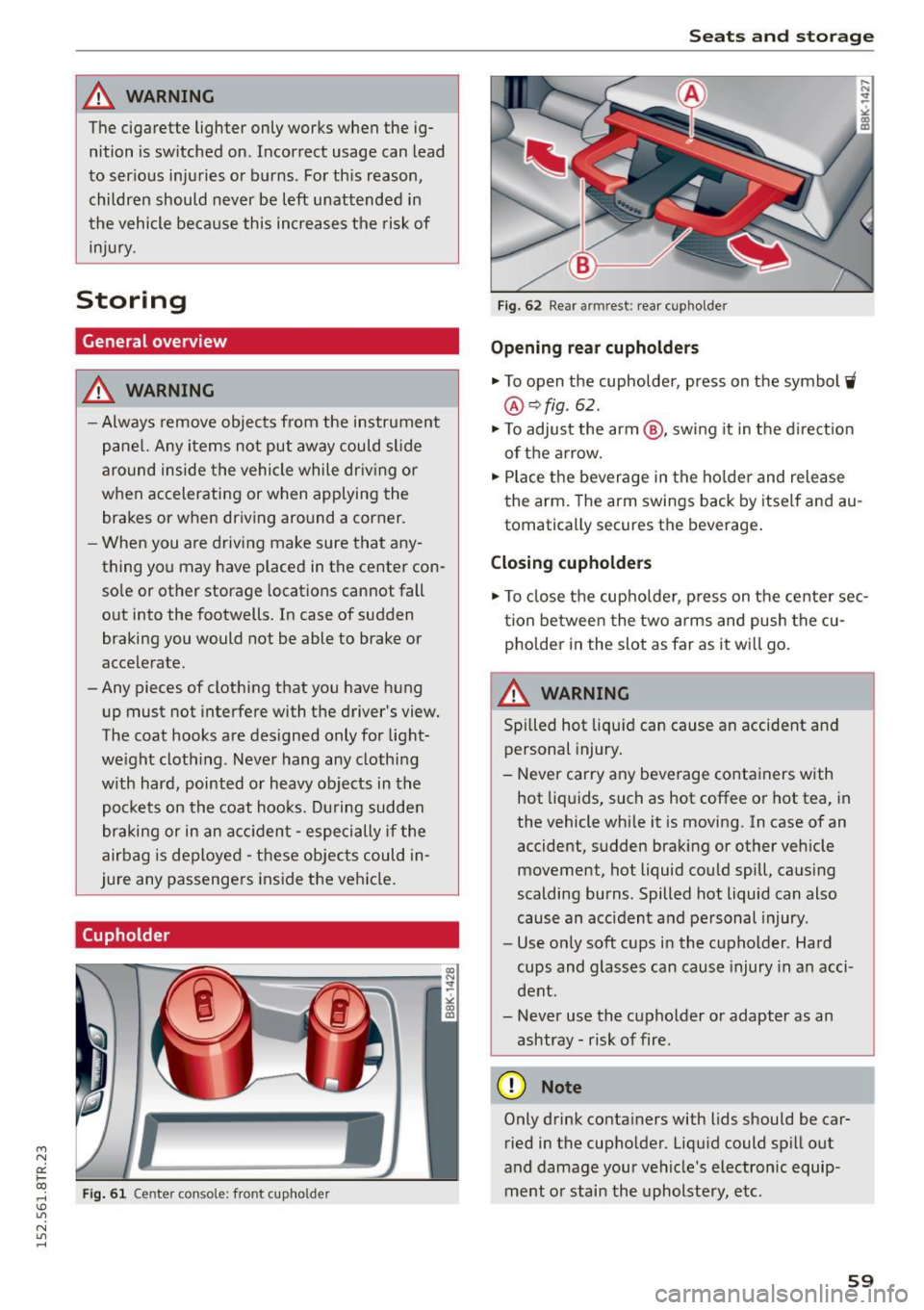
"' N
0:: loo
rl I.O
"' N
"' rl
_& WARNING
The cigarette lighter only works when the ignition is switched on. Incorrect usage can lead
to serious injuries or burns . For this reason,
children should never be left unattended in
the vehicle because this increases the risk of
injury .
Storing
General overview
_& WARNING
-Always remove objects from the instrument
panel. Any items not put away could slide
around inside the vehicle while driving or
when accelerating or when applying the
brakes or when driving around a corner .
- When you are driving make sure that any
thing you may have placed in the center con
sole or other storage locations cannot fall
out into the footwells. In case of sudden
braking you would not be able to brake or
accelerate.
-Any pieces of clothing that you have hung up must not interfere with the driver's view.
The coat hooks are designed only for light
weight clothing . Never hang any clothing
with hard, pointed or heavy objects in the pockets on the coat hooks. During sudden
braking or in an accident - especially if the
airbag is deployed - these objects could in
jure any passengers inside the vehicle.
Cupholder
Fig. 61 Cen te r con sole: fron t cupho ld er
Seats and storage
Fig. 62 Rear armrest: rear cup hol der
Opening rear cupholders
.,. To open the cupholder, press on the symbol W
@ ¢fig . 62 .
.,. To adjust the arm @, swing it in the direction
of the arrow.
.,. Place the beverage in the holder and release
the arm. The arm swings back by itself and au
tomatically secures th e be verage .
Closing cupholders
.,. To close the cupholder , press on the center sec
tion between the two arms and push the cu
pholder in the slot as far as it wi ll go.
A WARNING
Spilled hot liquid can cause an accident and
personal injury.
- Never carry any beverage containers with
hot liquids, such as hot coffee or hot tea, in
the vehicle while it is moving. In case of an
accident, sudden braking or other vehicle movement, hot Liquid could spill, causing
scalding burns. Spilled hot Liquid can also
cause an accident and personal injury.
- Use only soft cups in the cupholder . Hard
cups and glasses can cause injury in an acci
dent .
- Never use the cupholder or adapter as an
ashtray- risk of fire .
(D Note
Only drink containers with lids should be car
ried in the cupholder . Liquid could spill out
and damage your vehicle's electronic equip
ment or stain the upholstery, etc.
-
59
Page 62 of 254
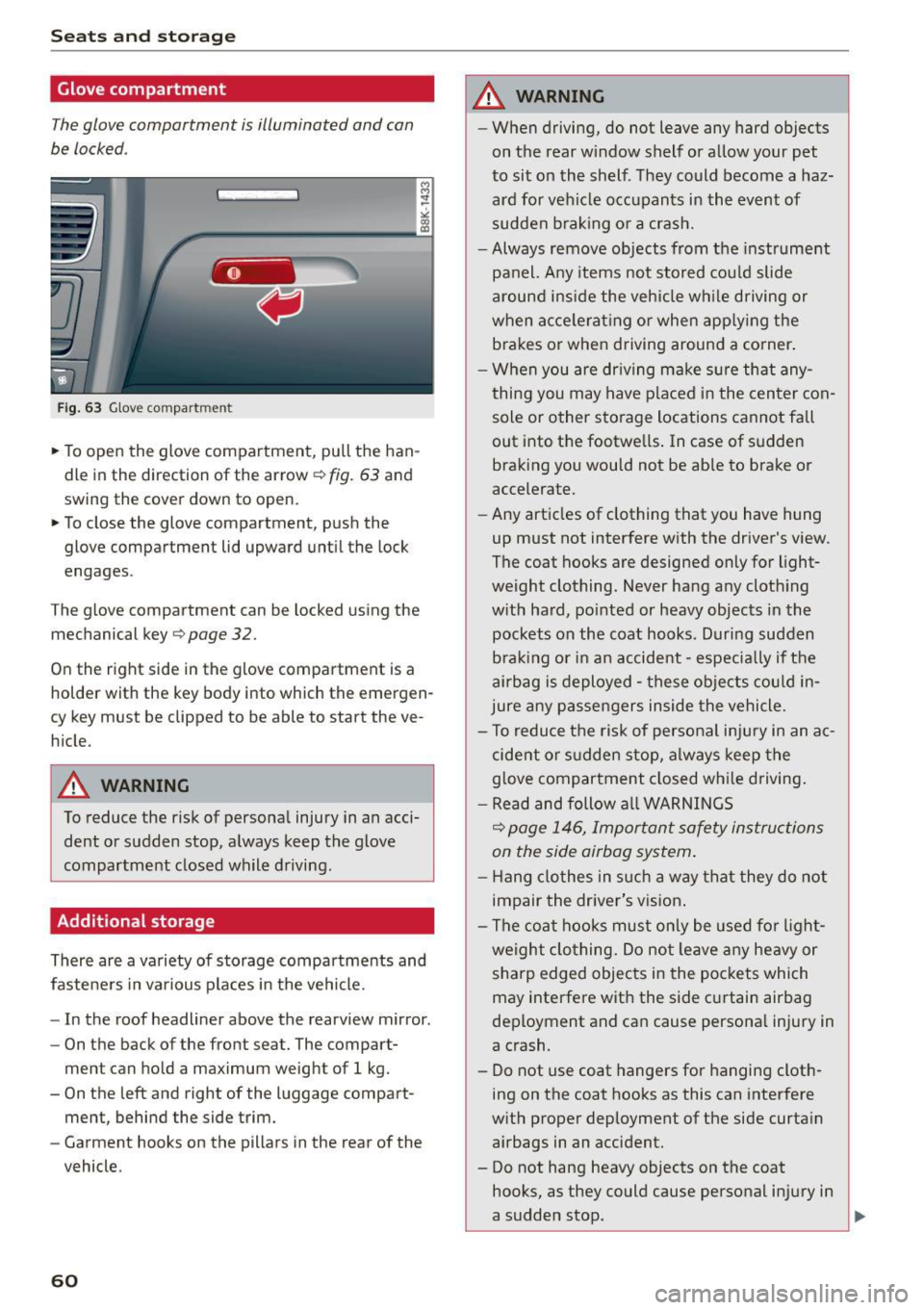
Seats and storage
Glove compartment
The glove compartment is illuminated and can
be locked .
Fig. 63 Glove compart ment
.. To open the glove compartment, pull the han
dle in the direction of the arrow
~fig. 63 and
swing the cover down to open.
.. To close the glove compartment, push the
glove compartment lid upward until the lock
engages .
The glove compartment can be locked using the
mechanical key
¢ page 32.
On the right side in the glove compartment is a
holder with the key body into which the emergen
cy key must be clipped to be able to start the ve
hicle.
A WARNING
To reduce the risk of personal injury in an acci dent or sudden stop, always keep the glove
compartment closed while driving.
Additional storage
There are a variety of storage compartments and
fasteners in various places in the vehicle.
- In the roof headliner above the rearview mirror .
- On the back of the front seat. The compart-
ment can hold a maximum weight of 1 kg.
- On the left and right of the luggage compart
ment, behind the side trim.
- Garment hooks on the pillars in the rear of the
vehicle.
60
A WARNING , -
- When driving, do not leave any hard objects
on the rear window shelf or allow your pet
to sit on the shelf . They could become a haz
ard for vehicle occupants in the event of
sudden braking or a crash.
-Always remove objects from the instrument
panel. Any items not stored could slide
around inside the vehicle while driving or
when accelerating or when applying the brakes or when driving around a corner.
- When you are driving make sure that any
thing you may have placed in the center con
sole or other storage locations cannot fall
out into the footwells. In case of sudden braking you would not be able to brake or
accelerate .
- Any articles of clothing that you have hung
up must not interfere with the driver's view .
The coat hooks are designed only for light
weight clothing. Never hang any clothing
with hard, pointed or heavy objects in the pockets on the coat hooks. During sudden
braking or in an accident -especially if the
airbag is deployed -these objects could in
jure any passengers inside the vehicle.
- To reduce the risk of personal inju ry in an ac
cident or sudden stop, always keep the
glove compartment closed while driving.
- Read and follow all WARNINGS
¢ page 146, Important safety instructions
on the side airbag system.
- Hang clothes in such a way that they do not
impair the driver's vision.
- The coat hooks must only be used for light
weight clothing. Do not leave any heavy or
sharp edged objects in the pockets which
may interfere with the side curtain airbag
deployment and can cause personal injury in
a crash.
- Do not use coat hangers for hanging cloth
ing on the coat hooks as this can interfere
with proper deployment of the side curtain airbags in an accident.
- Do not hang heavy objects on the coat
hooks, as they could cause personal injury in
a sudden stop .
~
Page 63 of 254
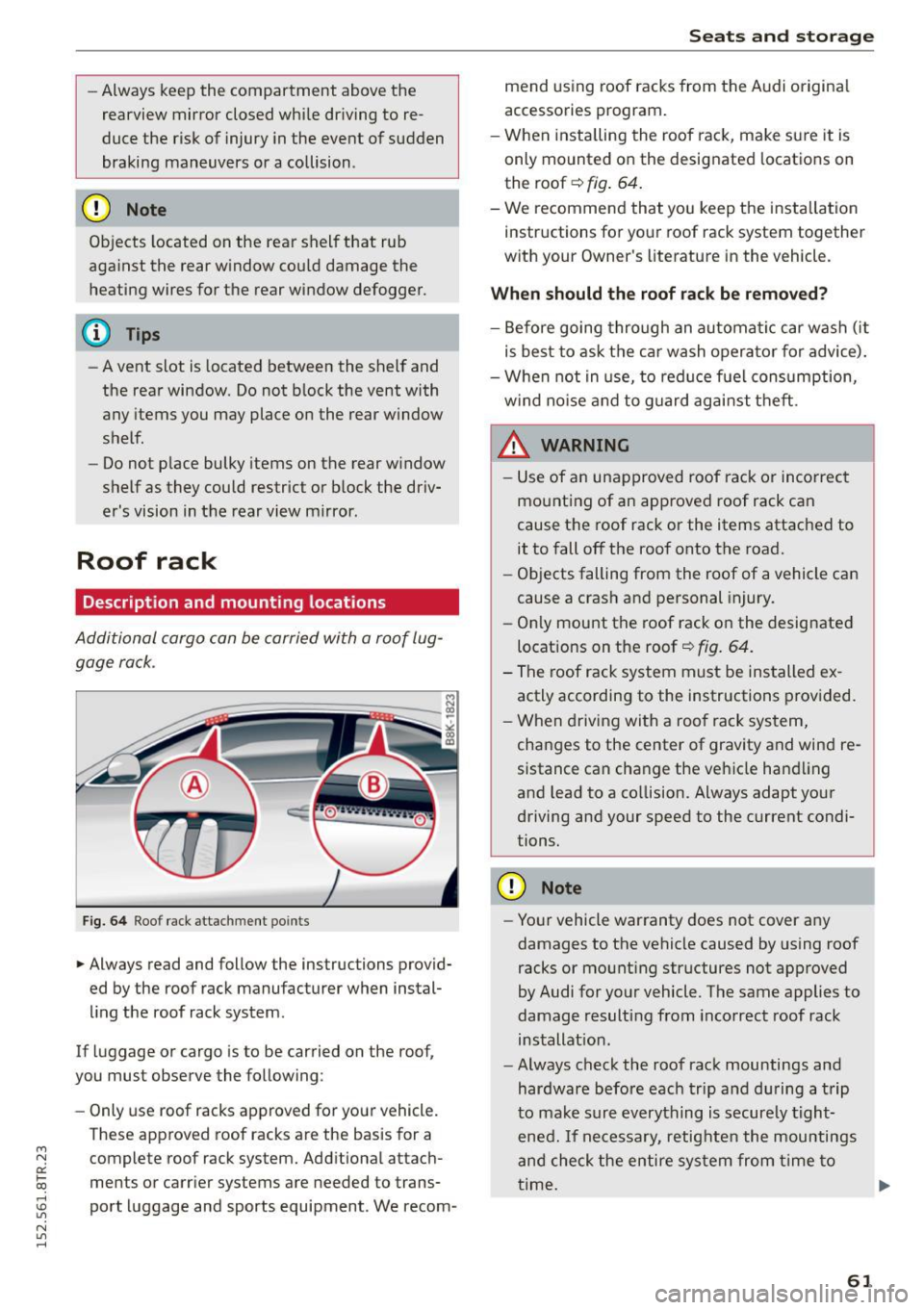
"' N
0:: loo
rl I.O
"' N
"' rl
-Always keep the compartment above the
rearview mirror closed while driving to re
duce the risk of injury in the event of sudden
braking maneuvers or a collision .
CJ) Note
Objects located on the rear shelf that rub
against the rear window could damage the
heating wires for the rear window defogger.
@ Tips
-A vent slot is located between the shelf and
the rear window. Do not block the vent with
any items you may place on the rear window
shelf.
- Do not place bulky items on the rear window
shelf as they could restrict or block the driv
er's vision in the rear view mirror .
Roof rack
Description and mounting locations
Additional cargo can be carried with a roof lug
gage rock .
Fig. 64 Roof rack attachment points
• Always read and follow the instructions provid
ed by the roof rack manufacturer when instal
ling the roof rack system .
If luggage or cargo is to be carried on the roof,
you must observe the following :
- Only use roof racks approved for your vehicle.
These approved roof racks are the basis for a complete roof rack system. Additional attach
ments or carrier systems are needed to trans
port luggage and sports equipment . We recom-
Seats and storage
mend using roof racks from the Audi original
accessories program.
- When installing the roof rack, make sure it is
only mounted on the designated locations on
the roof
c::> fig. 64.
- We recommend that you keep the installation
instructions for your roof rack system together
with your Owner's literature in the vehicle.
When should the roof rack be removed?
-Before going through an automatic car wash (it
is best to ask the car wash operator for advice).
- When not in use, to reduce fuel consumption,
wind noise and to guard against theft .
_& WARNING ,_____ -
- Use of an unapproved roof rack or incorrect
mounting of an approved roof rack can
cause the roof rack or the items attached to it to fall off the roof onto the road.
- Objects falling from the roof of a vehicle can
cause a crash and personal injury.
- Only mount the roof rack on the designated
locations on the roof
c::> fig . 64.
- The roof rack system must be installed ex
actly according to the instructions provided.
- When driving with a roof rack system,
changes to the center of gravity and wind re
sistance can change the vehicle handling
and lead to a co llision. Always adapt your
driving and your speed to the current condi
tions.
(D Note
- Your vehicle warranty does not cover any
damages to the vehicle caused by using roof
racks or mounting structures not approved
by Audi for your vehicle. The same applies to
damage resulting from incorrect roof rack
installation.
- Always check the roof rack mountings and
hardware before each trip and during a trip
to make sure everything is securely tight
ened. If necessary, retighten the mountings
and check the entire system from time to
time. ..,.
61
Page 64 of 254

Seat s and storage
- After mounting a roof rack system, or when
you transport objects on the roof of your ve hicle, the height of the veh icle is naturally
i ncreased . Be caref ul when driv ing under
l ow bridges or in parking garages for exam
ple. This cou ld cause damage to the load
and even the vehicle itself.
- Make sure that the open rear lid and the
sunroof do not come into contact w ith ob
jects on the roof.
Loading the roof rack
Always distribute loads evenly. Make sure any thing on the roof rack is securely tied down.
"' Always distribute the loads on the roof rack
evenly .
"' Always attach items to the roof rack securely
before you drive off .
The max imum perm issib le roof weight is
165 lb
( 75 kg ). The roof weight is the total of the
weight of the roof rack, the attachments and the
cargo yo u are carry ing . You must also not exceed
the maximum load weight fo r the roof rack you
are using.
When us ing a roof rack system w hich has a lower
load carrying capacity, you must not use up the
tota l maxim um permissible load carry ing capac i
ty spe cified above . In stead, you shou ld load the
roof rack sys tem only to the maximum capaci ty
specified by the manufact urer of the roof rack
system.
A WARNING
Weak, damaged or improper straps used to
secure items to the roof rack can fa il dur ing
hard brak ing or in a co llision and cause seri
ous pe rsonal injury.
- Make sure the roof rack is installed exactly
as specified above
r:!) page 61.
- Always use suitable mounting straps for se
curing items to the roof rack to help prevent
items from shifting or flying fo rward .
- Items on the roof rack must always be se
cu rely mounted.
62
-
- The use of a roof rack can negat ively affect
the way a vehicle handles. Cargo that is
large, heavy, bulky, long or flat will have a
greater negative influence on the vehicle's
aerodynamics, center of gravity and overall
handling . Always drive slowly, avoid sudden
bra king and maneuvers w hen transporting
c a rgo on the roo f of your veh icle.
- Never exceed the maxim um permissible
load ca rrying capaci ty of the roof of your ve
hicle, the perm iss ible axle weights and the
pe rm issib le tota l we igh t of your vehicle
r::!) page 233, Weights.
@ For the sake of the environment
As a result o f the increased wind resistance
create d by a roof rac k, yo ur vehicle is using
f u el unnecessarily. So remove the roof rack af
ter using it.
Luggage compartment
General information
_& WARNING
Read and follow the important sa fety precau
tions on
r::!) page 117, Storing cargo correctly.
Page 65 of 254
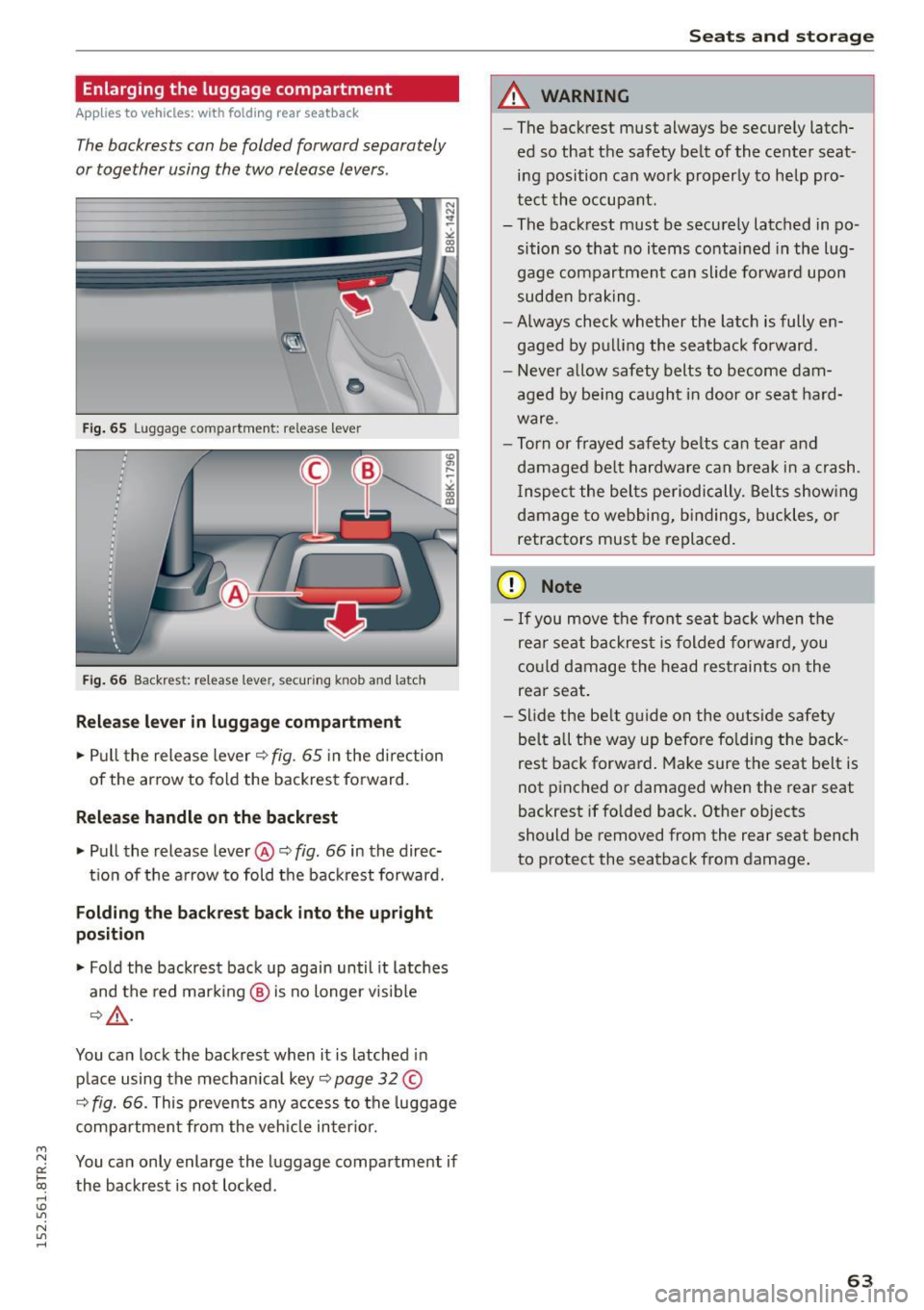
"'
Enlarging the luggage compartment
Applies to vehicles: with fold ing rear seatback
The backrests can be folded forward separately
or together using the two release levers.
Fi g. 65 Luggage compartment: release lever
F ig. 66 Backrest: release lever, sec uring knob and latch
Release lever in luggage compartment
• Pull the release lever Q fig. 65 in the direction
of the arrow to fold the backrest forward.
Release handle on the backrest
• Pull the release lever@~ fig. 66 in the direc-
t io n of the arrow to fold the back rest forward.
Folding the backres t back into the upright
position
• Fold the backrest back up again until it latches
and the red mar king @ is no longer v isible
Q ,&. .
You can lock the backrest when it is latched in
p lace using the mechan ica l key
~page 32 ©
Q fig. 66. This prevents any acces s to the luggage
compartment from the veh icle in ter ior.
~ You can only enlarge the luggage compartment if
txi the backrest is not locked. rl I.O
"' N
"' rl
Seats and storage
A WARNING
-
-The backrest must always be secure ly latch-
ed so that the safety be lt of the center seat
ing position can wo rk properly to help pro
t e ct the occupant.
- The backrest must be securely latched in po
sition so that no items conta ined in the Lug
gage compartment can slide forward upon
sudden b rak ing.
- Always check whether the latch is fully en
gaged by p ulling the seatback fo rward.
- Never allow safety b elts to become dam
aged by be ing caught in door or seat ha rd
ware.
- Torn or frayed safety belts ca n tear qnd
damaged be lt hardware can b reak i n a crash.
I nspect the bel ts periodically. Belts show ing
damage to webbing, bind ings, b uckles, or
retractors mus t be replaced.
(D Note
- If you move the front seat back when t he
rea r seat b ackres t is folded forwa rd, you
co uld damage the head restraints on the
rear seat.
- Slide the be lt g uide on the o utside safety
bel t all the way up befo re fo ld ing the back
rest bac k forwa rd . Make sure the seat belt is
not pinched or damaged when the rear seat
backrest if folded back. Other objects
should be removed from the rear seat bench
to protect the seatback from damage.
63
Page 66 of 254

Seats and storag e
Tie-downs and cargo net
Applies to vehicles: with cargo net
The cargo net prevents small objects from slid
ing.
F ig . 67 Luggage compartment: cargo net stretc hed out
Fig . 68 Luggage compartment: cargo net at the top of the
luggage compar tment
Net stretched out
.,. To secure objects with the cargo net, hang the
front hooks on the net in the t ie-downs first
and then hang the rear hooks¢
fig. 67 .
.,. Read and heed all WARNINGS ¢page 117,
Storing cargo correctly.
Net at the top of the lug gage comp artm ent
.,. Hang the hooks on the cargo net in the tie
downs on the floor at the rear of the luggage
compartment ¢
fig. 68.
.,. Fold down the hooks at the upper area of the
luggage compar tment down, pull the net up
and hang the eyelets on the net on the hooks .
.,. Read and heed all WARNINGS
¢page 117,
Storing cargo correctly.
You can also use the hooks ¢ fig. 68 to hang bags
and other objects. If nothing is hung on the
hooks, they will fo ld back in by themselves.
64
A WARNING
Weak, damaged or improper straps used to
secure items to tie-downs can fail during hard
braking or in a coll is ion and cause serious per
sona l injury.
-Always use su itable retain ing straps and
prope rly secure items to the tie-downs in
the luggage compa rtment to help prevent
items from shifting o r flying forward.
- Never attach a child seat tether strap to a
tie-down.
- For strength-related reasons, the mounting
hooks can only be used to secure objects
weighi ng up to 10 lb. (5 kg). Heav ier obje cts
w ill not be adequa tely secured -there i s a
ris k of injury.
Ski sack
Applies to vehicles: with ski sack
Long objects such as skis or snowboards can be
transported in the ski sack.
Fig . 69 Backrest: pass-t hro ug h cover
.,. To load the ski sack in the vehicle, fold the rear
center armrest down .
.,. Fold the pass-through cover down¢
fig. 69.
.,. Slide the ski sack from the luggage compart
ment through the opening w ith the zipper at
the rear.
.,. Sec ure the ski sack¢
page 65.
A WARNING
Objects m ust only be transported in the ski
sack since the ski sack can be secured . Individ
ua l objects cannot be secured . There is a risk
of injury.
-
Page 67 of 254
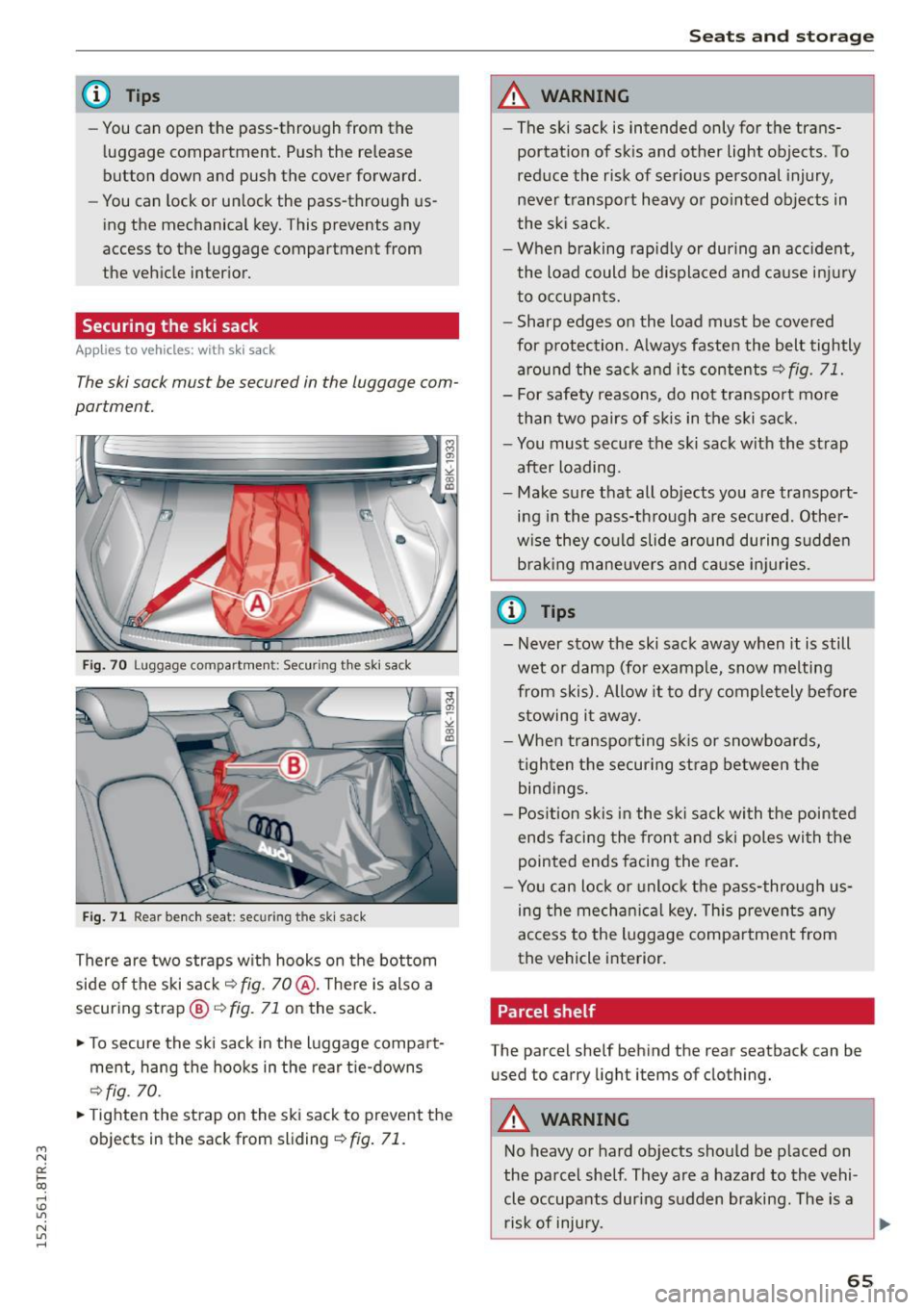
"' N
0:: ICC
rl I.O
"' N
"' rl
@ Tips
- You can open the pass-through from the
luggage compartment. Push the release
button down and push the cover forward.
- You can lock or unlock the pass-through us
ing the mechanical key. This prevents any
access to the luggage compartment from
the vehicle interior.
Securing the ski sack
Applies to vehicles: with sk i sack
The ski sock must be secured in the luggage com
portment.
Fig. 70 Luggage compartment: Securing the ski sack
Fig. 71 Rear bench seat: securing the ski sack
There are two straps with hooks on the bottom
side of the ski sack~
fig. 70@. There is also a
securing strap®~
fig. 71 on the sack.
~ To secure the ski sack in the luggage compart
ment, hang the hooks in the rear tie-downs
C?fig. 70.
~ Tighten the strap on the ski sack to prevent the
objects in the sack from sliding
~ fig. 71.
Sea ts and sto rage
A WARNING
-- The ski sack is intended only for the trans-
portation of skis and other light objects . To
reduce the risk of serious personal injury,
never transport heavy or pointed objects in
the ski sack.
- When braking rapid ly or during an accident,
the load could be displaced and cause injury
to occupants.
- Sharp edges on the load must be covered for p rotection. Always fasten the belt tightly
around the sack and its contents~
fig. 71.
- For safety reasons, do not transport more
than two pairs of skis in the ski sack.
- You must secure the ski sack with the strap after loading.
- Make sure that all objects you are transport
ing in the pass-through are secured. Other
wise they could slide around during sudden b rak ing maneuvers and cause injuries.
(l} Tips
- Never stow the ski sack away when it is still
wet or damp (for example, snow melting
from skis). Allow it to dry completely before stowing it away.
- When transporting sk is or snowboards,
tighten the securing strap between the bindings.
- Pos ition skis in the sk i sack with the pointed
ends facing the front and ski poles with the
pointed ends facing the rear.
- You can lock or unlock the pass-through us
ing the mechan ical key. This prevents any
access to the luggage compartment from
the vehicle interior.
Parcel shelf
The parcel shelf behind the rear seatback can be
used to carry light items of clothing.
A WARNING
-
No heavy or hard objects should be placed on
the parcel shelf. They are a hazard to the vehi
cle occupants dur ing sudden braking. The is a
risk of injury.
~
65
Page 68 of 254
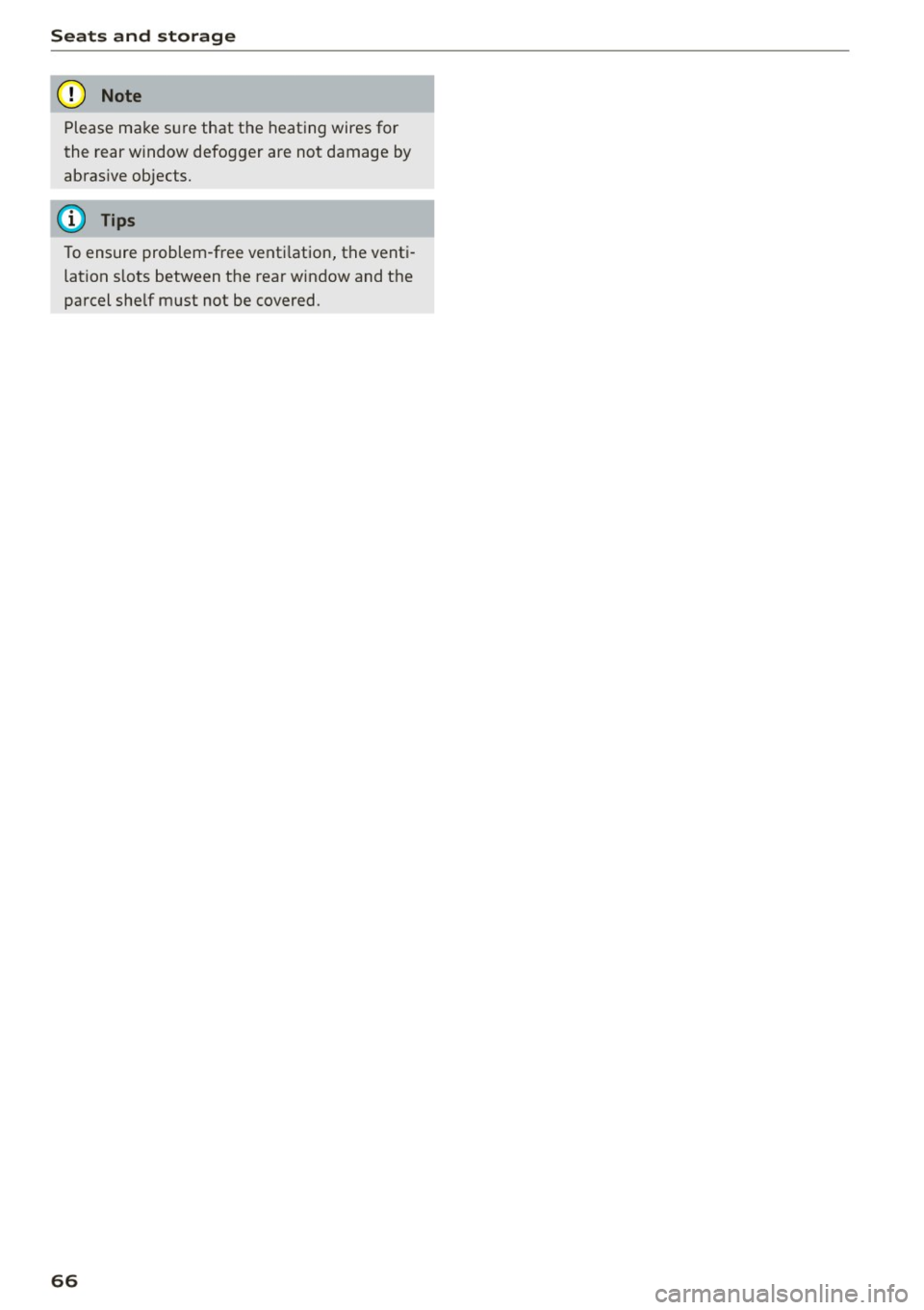
Seats and storage
CJ) Note
Please ma ke s ure that the heat ing wires for
the rear window defog ger are not damage by
abras ive objects.
@ Tips
To ensure problem-free vent ilation, t he vent i
lat io n slo ts between t he rear win dow and t he
parcel she lf m ust not be covered.
66
Page 69 of 254
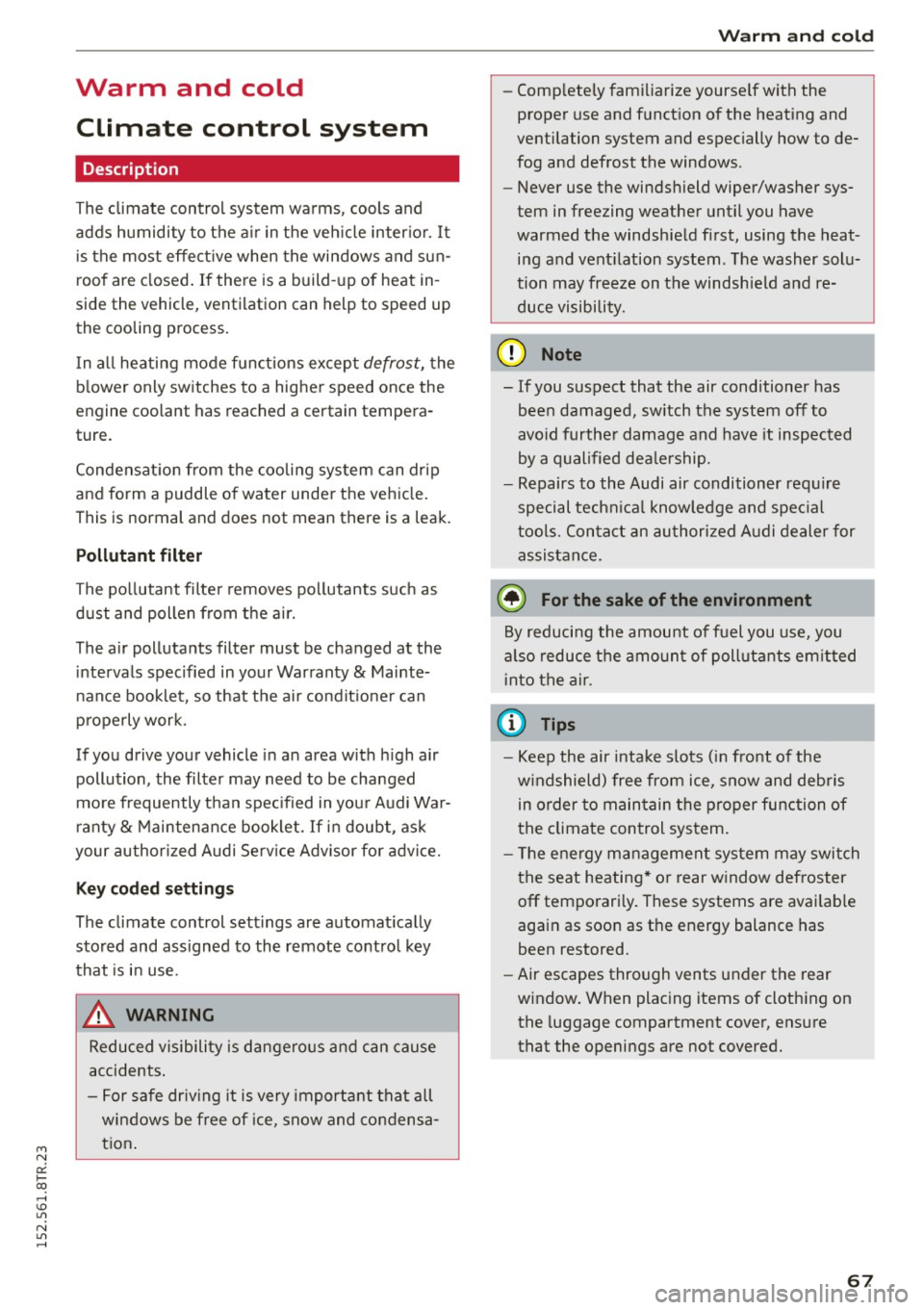
M N
0:: loo ,...., \!) 1.1"1
N 1.1"1 ,....,
Warm and cold Climate control system
Description
The climate control system warms, cools and
adds humidity to the a ir in the veh icle inter io r.
It
is the most effect ive when the windows and sun
roof are closed. If there is a build-up of heat in
side the vehicle, ventilation can help to speed up
the cooling process.
I n all heating mode functions except
defrost, the
b lower only switches to a higher speed once the
engine coolant has reached a certain tempera
ture.
Condensat ion from the cooling system can drip
and form a puddle of water unde r the vehicle.
This is normal and does not mean there is a leak.
Pollutant filter
The pollutant filte r removes pollutants such as
dust and pollen from the ai r.
The air pollutants filter must be changed at the
intervals specified in your Warranty & Mainte
nance booklet, so that the a ir condit ioner can
properly work.
If you drive your vehicle in an area with high air
pollution, the filter may need to be changed
more frequently than spec ified in your Audi Wa r
ranty
& Maintenance booklet. If in doubt, ask
your authorized Audi Service Adv isor for advice.
Key coded settings
The climate control settings are automat ically
stored and assigned to the remote control key
that is in use.
_&. WARNING
Reduced visibility is dangerous and can cause
accidents .
- For safe dr iv ing it is very important that all
windows be free of ice, snow and condensa
tion .
Warm and cold
-Comp letely familiarize yourse lf with the
proper use and funct ion of the heating and
ventilation system and especially how to de
fog and defrost the windows.
- Never use the windshield wiper/washer sys
tem in freezing weather until you have
warmed the windshie ld first, using the heat
ing and vent ilation system. The washer solu
tion may freeze on the windsh ield and re
duce visibility.
(D Note
- If you suspect that the air conditioner has been damaged, sw itch the system off to
avoid further damage and have it inspected
by a qualified dealership.
- Repairs to the Audi air conditioner require
special techn ical knowledge and spec ial
tools. Contact an authorized Aud i dealer for
assistance.
@ For the sake of the environment
By reducing the amount of fuel you use, you
also reduce the amount of pollutants emitted
into the air.
(D Tips
- Keep the air intake slots (in front of the
w indshield) free from ice, snow and debris
in order to main tain the proper function of
the climate control system.
- T he energy management system may switch
the seat heating * or rear window defroster
off temporarily. These systems are avai lab le
again as soon as the energy balance has
been restored.
- Air escapes through vents under the rear
window. When placing items of cloth ing on
the luggage compartment cover, ensure
that the openings are not covered.
67
Page 70 of 254

Warm and cold
Operation
We recommend pressing the !AU TO ! button and setting the temperature to 72 °F (22 °C).
Fig . 72 Automatic climate control sys tem: control
F ig . 73 3-zone del ux e automat ic climate controt•: controls
Press the buttons to turn the functions on or off.
Use the dials to adj ust the temperature, the
b lo wer speed and the air distribution. The LED in
a button will light up when the function is
switched on. The settings are displayed for a few
seconds in the radio or MMI* display.
In vehicles with a 3-zone deluxe automatic cli
mate control systems*, the driver and front pas
senger side can be adjusted sepa rately. The set
tings are also disp layed in the climate control
system display .
68
I OFFI Switching the climate control system
on/off
The ! OFF ! button switches the climate contro l
system on or off.
It also switches on when you
press the knob. Airflow from outside is blocked
when the cl imate control system is switched off.
IA/C l Switching cooling mode on/off
The air is not cooled and humidity is not removed
when coo ling mode is switched off. This can
cause fog on the windows. The cooling mode is
switched off automatically at low outside tem
peratures.